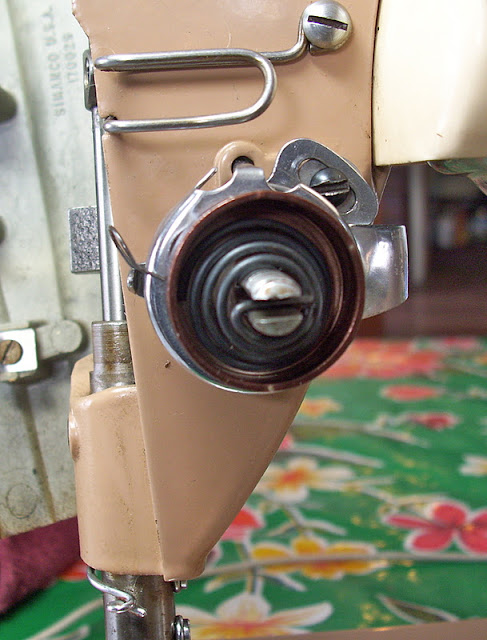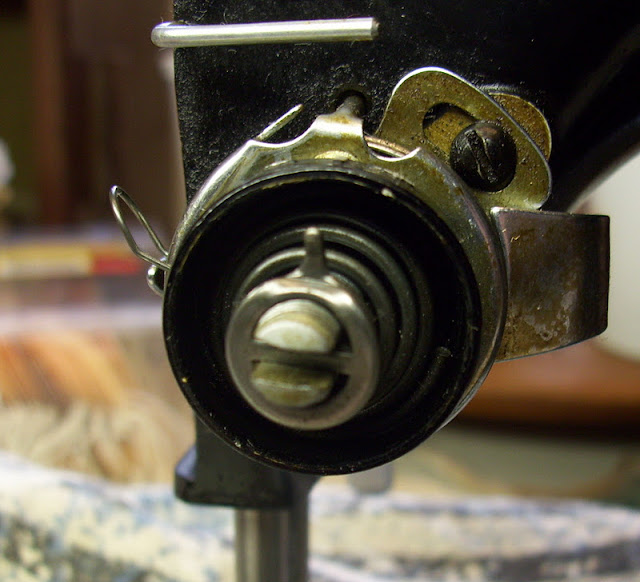The 221 and the 301 tension assemblies are very similar. I volunteered to do a post specifically for the 301 tension assembly. Here it is
A bit of anatomy first:
Open the face plate and look inside. Here you will find the tension release spring which is attached to the tension release lever (the lever that lifts the presser foot); the tension release pin and the set screw.
This is the same view with the presser foot up. If you play with your machine a bit, lifting the presser foot and then putting it down, you will see that the tension discs release with the foot up. That is because the pin is pushed in and the discs are loose.
Theoretically if you release the set screw you can remove the whole tension assembly intact. I couldn't seem to do that on my machine this morning so I didn't. Instead I started at the outside and worked in.
I have a plastic ice cube tray that I use to keep the individual pieces organized. I can put a little denatured alcohol in each little cube so that the parts can soak while I am dis-assembling.
First I turned the chrome knob all the way, as loose as it would go. Then I pushed on the numbered dial to release the little stud in the chrome knob and removed the knob
Once the chrome knob is removed, you can see the numbered dial simply sits on the tension stud.
When you remove that, you see the stop washer. Take note of its position.
Once the stop washer is removed, the spring is revealed:
Then the spring housing:
The tension discs and check spring all come out together.
Finally the thread guide comes off. I put that little screw right back in its home, so I don't lose it.
Now I loosen the set screw and release the stud.
Within the stud is the tension release pin. It is best not to lose this. As you can see the pin can slip out of the stud only one way. Some folks are known to use a small finish nail to replace the tension release pin. You can see why it would work. That end of the pin looks just like the end of a finish nail.
Now that your tension assembly is apart, you can clean all the parts. I use denatured alcohol. I used to use isopropyl rubbing alcohol, but I like denatured better. I think it might have less water content.
Once your parts are clean, it is a matter of putting things back in the order they came out.
First the tension stud with the pin placed inside properly (head oriented in the stud as it is the photo above). If you, like me, prefer your -/+ spring housing to sit horizontally, you need to make sure that the tension stud is oriented as indicated in the photo.
Tighten the set screw. This picture shows off my Brownell Bits. I love them. This is a 150-3 sized bit. Fits perfectly. (I know that the bit is not in the screw properly. I only have two hands and I had to hold the camera too)
Next place the thread guide. I try to replace it as close to the original position as I can. I can fine tune this later if needed.
The tension discs go next. The only reason that I point out this next step is that I have replaced these discs incorrectly, even though I KNOW how they should go.
Sandwiched in between the other disc (the one with the stud) and the check spring.
The spring is positioned over the tension stud inside of the machine housing. Be sure to position the check spring accordingly above the "stop" on the thread guide. As you can see, the stud on the third disc fits back into that little hole just to the right of my red circle.
The spring housing goes next and then the spring
The stop washer fits in over the spring. I think it is important that the spring be positioned as it is in the above photo so that the stop washer can fit correctly.
The numbered dial goes next. Somewhere I read that the number 2 goes on top of the tail on the stop washer. I have no idea why, or if it makes a difference. I do try to do it, though.
Then, like before, you have to pinch the numbered dial in to replace the chrome knob.
Then the chrome knob goes on. Once your get it started on the threads, twist it on a bit before relaseing the numbered dial. The dial will catch on the little stud on the knob and voila, you are done, almost...
Test stitch and see how your tension looks.
A very wise Bill Holman of Vintagesingers (http://groups.yahoo.com/group/vintagesingers) suggested that I re-word my instructions. So I have cut and pasted his suggestion here. He is the smartest man on the planet when it comes to these machines. I am honored that he read my blog and took the time to make this suggestion.
I would suggest something more like: Once the tension is adjusted so that it is
correct on your test fabric, push in on the numbered dial while holding the knob
in position, rotate the dial to 3 or 4, and let it pop back out against the
knob.
.





















































